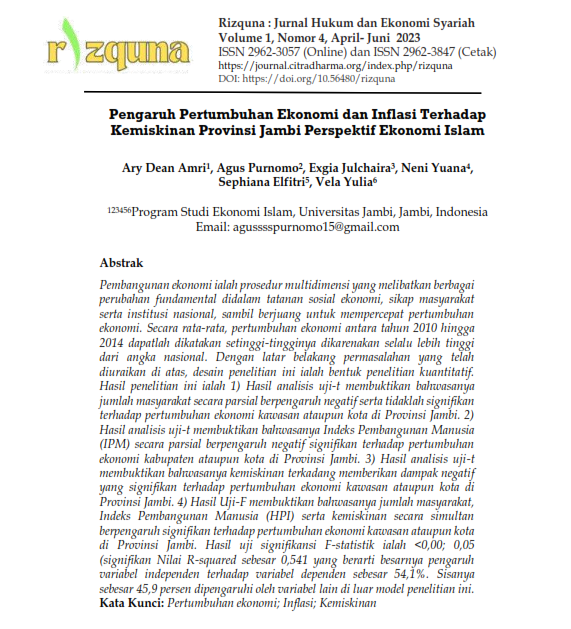Pengaruh Pertumbuhan Ekonomi dan Inflasi Terhadap Kemiskinan Provinsi Jambi Perspektif Ekonomi Islam
DOI:
https://doi.org/10.56480/rizquna.v1i4.868Keywords:
Economic growth, Inflation, PovertyAbstract
Economic development is a multidimensional procedure that involves fundamental changes in the socio-economic order, social attitudes and national institutions, while striving to accelerate economic growth. On average, economic growth between 2010 and 2014 can be said to be the highest because it is always higher than the national rate. With the background of the problems described above, the design of this research is a form of quantitative research. The results of this study are 1) The results of the t-test analysis prove that the number of people partially has a negative and insignificant effect on regional or city economic growth in Jambi Province. 2) The results of the t-test analysis prove that the Human Development Index (IPM) partially has a significant negative effect on the economic growth of districts or cities in Jambi Province. 3) The results of the t-test analysis prove that poverty sometimes has a significant negative impact on regional or city economic growth in Jambi Province. 4) The results of the F-test prove that the number of people, the Human Development Index (HPI) and poverty simultaneously have a significant effect on the economic growth of regions or cities in Jambi Province. The results of the F-statistical significance test were <0.00; 0.05 (significant R-squared value of 0.541, which means the magnitude of the influence of the independent variable on the dependent variable is 54.1%. The remaining 45.9 percent is influenced by other variables outside this research model.

Downloads
Published
Issue
Section
License
Copyright (c) 2023 Ary Dean Amri, Agus Purnomo, Exgia Julchaira, Neni Yuana, Sephiana Elfitri, Vela Yulia

This work is licensed under a Creative Commons Attribution-ShareAlike 4.0 International License.







